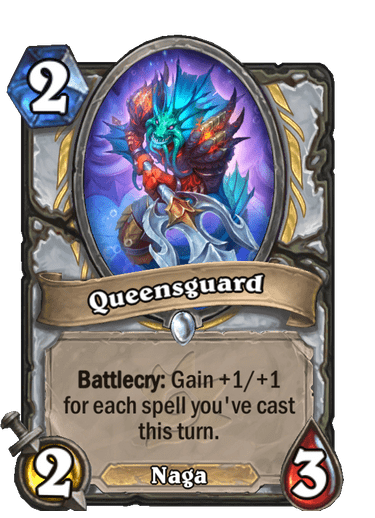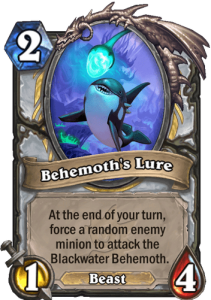
Illuminate

This card doesn’t do anything by itself, but its 0-mana cost and utility could make it a useful card. The class is highly encouraged to run a lot of cheap spells, chain them together and mass draw. Illuminate is a decent enabler for this kind of strategy. It also works well with Azsharan Ritual, but this specific use seems to be limited to one strategy.
Score: 2
Queensguard

This innocent looking 2-drop could be a giant in disguise. With Priest’s new card draw and mana cheating tools, we can see Queensguard become a massive threat following a big flurry of spells. It’s the perfect addition to a Handmaiden-fueled deck. Even if we play one spell, it’s already Spider Tank for 2 mana, and we strongly suspect it will usually be bigger than that. The upside and late game scaling is significant. This is Biteweed for spells on a bigger body.
Score: 3
Switcheroo

Arcane Intellect that tutors minions with the potential of a big stat swing. Alternatively, we can compare it to Shroud of Concealment and quickly conclude it is straight up stronger. For example, we can play this in a Kazakusan Priest deck and hit an 8/8 Lightmaw Netherdrake. We can play it in a Big Priest and cheat out some stats earlier than we’re supposed to. But the simplest usage can completely ignore the stat swap ability and focus on the fact we can now draw 2 minions for 3 mana in Priest. This would boost the consistency of any ‘Miracle’ Priest deck that’s light on minions and dense with spells. Switcheroo will be ubiquitous.
Score: 4
Whispers of the Deep

This might be one of the strongest Silence Priest cards we’ve ever seen. The problem for the archetype has often been its ability to come back from falling behind and Whispers of the Deep provides a back-breaking swing attached to a silence effect. Selfish Shellfish looks like a particularly tasty target. If we were confident that Silence Priest would be competitive, we would give this card a higher score, but we’re not.
Score: 2
Handmaiden

This card transforms Priest into a card drawing maniac class at the level of Rogue. Handmaiden gives us Field Contact vibes. It doesn’t have as big of a ceiling in terms of drawing power, but it’s far easier to activate and the class has similar means of drawing it very consistently to make its requirement less restrictive. There’s a chance it might be a bit difficult to utilize at the beginning of the format, but the more cheap spells Priest gets over time, the closer Handmaiden gets to completely change the way the class approaches the game.
Score: 4
Azsharan Ritual


Strictly stronger Unsleeping Soul and a clear attempt to bring Silence Priest back, with the archetype only exhibiting a competitive power level years ago during Journey to Un’Goro. Priest does have a pretty good way to dredge the Sunken version of the card, but Ritual’s narrow usage in one specific strategy makes it a card we can’t be overly confident about.
Score: 2
Serpent Wig

This card is very inefficient as a buff, giving a mere 1/1 in stats for 1 mana. The question is whether we’re that desperate for cheap spells to include it in a Miracle Priest type of deck with a package of Nagas. We would never look at this card’s direction if Radiant Elemental weren’t in the Core set, and now that it is, there’s a chance Serpent Wig could find its way to a deck.
Score: 2
Whirlpool

A worse version of Plague of Death as it doesn’t cleanly deal with deathrattles for a Flik Skyshiv ability that could be relevant in some matchups. Plague of Death mostly saw play in a Highlander deck that was desperate for any bits of removal it could find, so we’re not too high on Whirlpool’s chances of making it. It’s very expensive and we would expect it to be a fringe card in the format at best.
Score: 2
Priestess Valishj

Valishj is a massive enabler for a potentially new Miracle Priest deck that can draw cards as quickly as Garrote Rogue. It’s a good thing she “only” refreshes mana crystals, as she would be broken beyond belief otherwise. Extremely versatile and doesn’t need the best-case scenario to swing the game in your favor. Just playing a couple of spells means you get a free Mana Biscuit attached to a Wisp and there will be situations where she gains 5-6 mana in a single turn and just wins the game. We would be shocked if this card didn’t become a meta-defining component in the format at some point in the future, even if it didn’t make an impact instantly. The question is when, not if.
Score: 4
Blackwater Behemoth


Probably the most disappointing colossal of this set. This card would be better in most situations if it simply had rush instead of being colossal. Behemoth is essentially a minion that randomly rushes into an opponent’s minion, and this ability is not even attached to the main body, but to a small token that can be easily cleared the next turn. We suspect that Behemoth will almost never attack the next turn, let alone doing it twice. Not sure why we would ever put this into our deck. There are more efficient ways to remove and heal.
Score: 1
Final Thoughts
Voyage to the Sunken City Set Rank: 5th
Overall Power Ranking: 4th
Priest has a very exciting set, but perhaps its core set is the cause of bigger excitement. The return of Northshire Cleric, Radiant Elemental, Lyra the Sunshard as well as Pyro/Acolyte/Tol’vir has players salivating over the potential return of an “Inner Fire” combo Priest, this time running Bless. The introductions of Handmaiden, Switcheroo, Queensguard and Priestess Valishj have further fueled such hopes. Priest might be able to draw cards faster than Rogue now. Its ability to control the board through removal has drastically dropped in quality while its combo shell potential has emerged instantly.
But here’s the problem. It’s so difficult to figure out Priest, mostly because one critical piece is missing: Divine Spirit. How does this incredible card drawing shell close out games? We think people may eventually figure it out, but this is quite the conundrum that dawned on us while theorycrafting. There’s a lack of lethality.
A similar issue emerges with Silence Priest. This is an archetype that has only been competitive once in Hearthstone’s history. It got some great tools, but we still fear it may not be enough.
Looking for a way to close out games? Slower Priest strategies may find a solution. Kazakusan Priest received Drakonid Operative to shore up its mid-game. This deck has been bad throughout Onyxia’s Lair but perhaps it will have a better chance competing against a weaker format. Quest Priest carries the most dramatic and clear-cut finisher, and this is one archetype where Reno Jackson could make the most sense. After all, we’re just looking to play cards on curve and survive. We don’t need to do anything special when it comes to synergies.
Solve the Miracle Priest equation and you will have a top tier Hearthstone deck in the Sunken City. Otherwise, that hype could be for nothing, though it might be just a matter of time.
